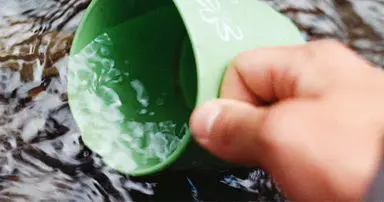Pure Tallow Soap Recipe
- 30 oz tallow or lard
- 3.88 oz 100% pure lye (where to buy pure lye) >
- 11 oz distilled water
*When making soap, always measure by WEIGHT, not by volume
Melt the tallow in the crock pot (or a pot over the stove if you’re in a hurry).
Once the fat is nearly all melted, put on your safety gear and carefully measure the lye.
In an area with good ventilation (I do this under with my oven fan on), carefully stir the lye into the measured water. ALWAYS add the lye to the water– do NOT add the water to the lye, as it can result in a volcano-like reaction.
Stir this lye/water mixture until it has dissolved and let it sit for a few minutes. There will be a chemical reaction between the lye and water, and the water will become very hot, so be careful handling the container.
Place the melted tallow in the crockpot (if it’s not already there), and slowly stir the lye/water mixture in.
Switch to an immersion blender (trust me, unless you want to stand there stirring for an hour, you’ll use an immersion blender), and proceed to blend the tallow, lye, and water until you reach trace.
Trace is when the mixture turns to a pudding-like consistency and holds its shape when you drip a bit on
top.
Trace can take anywhere from 3 to 10ish minutes to achieve.
Now put the lid on the crockpot, set it on LOW, and allow it to cook for 45-60 minutes. It will bubble and froth, which is fine. Just keep an eye on it to make sure it doesn’t attempt to bubble out of the pot. If it attempts an escape, just stir it back down.
Once it has cooked for a while and passes the “zap” test (test the soap to make sure the lye has reacted with the oils completely and no longer remains in the mixture. I like to do this by grabbing a small amount of the soap mixture, allowing to cool for a second, and then touching it to my tongue. If it “zaps” me, I know there is still lye remaining in the mixture and it needs to cook longer. If it just tastes like soap, we’re ready for the next step) pour/scoop it into a mold and allow it to set for 12-24 hours.
Remove the solid soap from the bar, cut into bars, and allow to cure for 1-2 weeks. You can technically use the soap right away, but the dry time will produce a nicer, harder bar of soap.
Tallow Coconut Oil Soap Recipe
- 20 oz tallow or lard
- 10 oz coconut oil (I use expeller-pressed coconut oil– it has no coconut scent and is cheaper)
- 4.37 oz 100% pure lye (where to buy)
- 9 oz distilled water
Follow the above directions for pure tallow soap, melting the coconut oil in with the tallow in the first step.
Tallow Soap Notes:
- Why distilled water? Tap water can contain a variety of minerals which may cause weird results in the final soap. It’s best to remove this variable by simply using distilled water.
- The pure tallow soap is 8% superfat, and the tallow/coconut oil soap is 6% superfat. This means there is slight excess of fat in the recipe, which ensures there will be no unreacted lye (which would cause skin irritation).
- This is the soap mold I’ve been using. It’s cheap and perfect for smaller batches.
- This is where I get my coconut oil. I buy it in 5 gallons buckets and it lasts FOREVER.
- Does it smell weird? My tallow soap has a bit of a “fatty” smell, but it’s not offensive (at least to me). And it does NOT smell like rendering tallow, which is good, because that’s an icky smell.
- Can you add essential oils to this soap? Yes, you can. If you do, add it at the very end right before you place it into the mold. However, like I’ve mentioned in the past, it takes a LOT of essential oil to make soap smell strong. If you’re using high-quality essential oils like I do, this usually isn’t an option as it makes your homemade soap pretty costly, pretty quick. Therefore, I tend to leave my soap unscented. Or you can just purchase fragrance oils designed for soaping.

























0 Comments